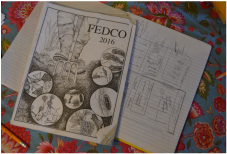 This is honesty - first draft of this year's herb garden plan.
This is honesty - first draft of this year's herb garden plan. But. . .
I just ate delicious pumpkin-apple soup and cornbread for lunch. Tonight we'll have pesto for the adults and tomato sauce for the kids and spiced peaches for dessert. It is February, the ground is solid and covered by a thin layer of ice and several inches of snow, and we are eating from our garden. Even my haphazard planning is paying off, and it wasn't always so. In order to eat all year - start planning now.
The first year of our own grown-up garden, we grew a lot of food. The only things we had enough of to last throughout the year - squash (I've never had a squash year like it since) and cucumbers (bread and butter and dill - jars and jars). A neighbor let us pick apples and pears and I dried and I froze. We really enjoyed that fruit all year. (Notice I did not mention the squash or vats of pickles.)
The next year we grew all of our garlic for the year and tomato products. I love green salsa, so we added cilantro and tomatillos the next year. My husband rolls his eyes heavenward when eats pesto, so we grew mounds of basil, too.
Turns out a row of edamame was a great experiment and now we freeze bags of "pop beans."
We stacked the winter squash in baskets on the porch and in the cooler parts of the house last year for decoration. Every now and then I would check them and cook up the ones that looked like they might go soon. We had so many, we lost some. Winter squash is delicious. A moment of silence.
We compete with the wilderness for our beans, but three years ago with good fencing we dried and froze enough for the year.
What you may notice is that not every type of produce gets mentioned for every year. It turns out that whatever I plan for best (excepting flooding and drought conditions), does the best. Load of composted manure to the tomato patch = great tomatoes. Fencing around the beans = bean-shelling party! Each year the pantry is a little better, but planning is the key. There are many methods of eating from the garden all season - cold frames, freezing, canning, drying, greenhouses, mulching, root cellars - but producing the right amounts of food for a family requires planning.
So we're planning. We're planting a few of the little garden peach tomatoes my middle kiddo can eat until he's sick and the cherries right off the vine and 20 good paste and drying tomato plants. We've reduced the greens to a good patch of sturdy greens that will keep us eating really late and really early, but the cut and come again lettuce gets a smallish- patch every two weeks. There's only so much we can consume. Mama's putting some fencing around the freezer peas to keep out the children - kids don't care, they will eat every whether its moniker containers Sugar or not - we'll add a lot more snaps for them, don't worry!
We are learning about quantity - we do not need 25 quarts of pickles at our house.
For us - about 25 quarts of tomato sauce in storage (not counting what we make fresh in season), 5-10 quarts of salsa, 5 quarts of frozen cherry tomatoes, 5 quarts of edamame is plenty, 20 pints of jam/jelly (We have three kids!), 3-4 quarts of pickles (that one year drove it out of us), and so on and so forth.
We also add giving to growing. We visit our neighbors on winter solstice with loaves of bread and jars of jam. We take jars on our journeys, sharing with those friend and family that live near great vacation spots, but have nothing like our Kentucky garden.
Our pesto demand may change as the kids' taste buds mature toward adulthood, and we are ready. Right now we leave the mounds of extra basil in the front garden - seed is cheap, it smells wonderful, and the frost-killed, blackened stalks are a perfect backdrop for our Halloween party.
Planning Steps
- Estimate or even track how much your family consumes of the things you want to grow
- Does this reflect how much of those things you want to consume? For instance, we don't eat pesto when we don't grow it - it is very expensive for our budget, or when I know I have a lot of beans to work with, we eat them because they are healthier than other types of proteins.
- Decide how you will store these foods - in the ground, root cellar, canned, frozen
- Make sure you have storage available. Sometimes you can improvise - when we ran out of cans one year, I started freezing.
- Choose produce varieties good for what you need to do with them. Paste tomatoes for cooking down, meaty tomatoes for drying. . .
- Decide how many pounds you will need to produce to meet your families' needs. You can find great plant-yield ratio materials easily.
- Create your garden plan, including dates to start seeds, plant outside, and estimated dates of harvest. It's hard to put up a year's worth of strawberries, if you are on vacation!

 RSS Feed
RSS Feed